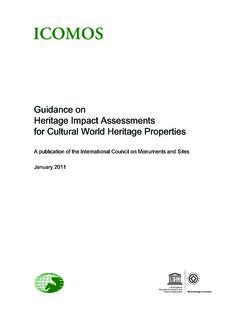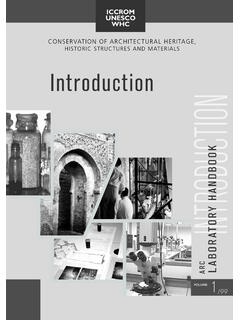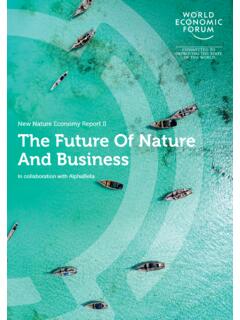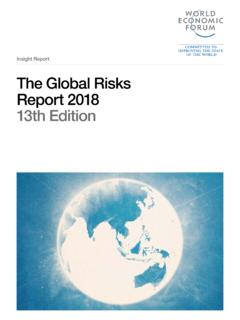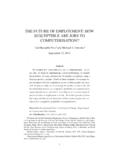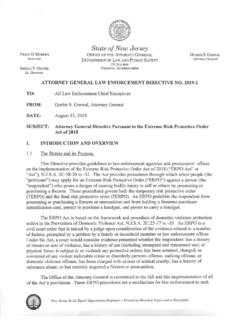Transcription of A Guide to Risk Management of Cultural Heritage
1 A Guide to Risk Management of Cultural HeritageInternational Centre for the Study of the Preservation and Restoration of Cultural PropertyCO - CRE ATIONC oncept and textJos Luiz Pedersoli Jr., Scientia Pro CulturaCatherine Antomarchi, ICCROM - International Centre for the Study of the Preservation and Restoration of Cultural PropertyStefan Michalski, Canadian Conservation InstituteReview, copy-editing and productionZaki Aslan & Anwar Sabik, ICCROM-ATHAR Regional Conservation Centre, Sharjah, UAEI nformation design and visualisationChristopher Malapitan & Mar a Foulqui , VisualityCover design Mohammed Irqsosy, Maxreative, UAER esearchJos Luiz Pedersoli Jr., Scientia Pro CulturaStefan Michalski, Canadian Conservation InstituteCopyright ICCROM, 2016 Government of Canada, Canadian Conservation Institute, 2016 Acknowledgment - 3 AcknowledgmentThis Guide is an abridged version of the 2016 handbook The ABC method - A risk Management approach to the preservation of Cultural Heritage , a joint publication of the Canadian Conservation Institute (CCI) and ICCROM, written by Stefan Michalski (CCI) and Jos Luiz Pedersoli Jr (for ICCROM).
2 The ABC method evolved during ten years of teaching a three week ICCROM course on Reducing risks to Collections to experienced professionals throughout the world, in partnership with the Cultural Heritage Agency of the Netherlands (RCE) and the Central Institute for Conservation in Serbia (CIK). The purpose of this booklet is to introduce this most recent thinking on how to achieve effective preservation to anyone responsible for its planning and authors wish to acknowledge the contribution of all colleagues and organizations who participated in the development of the ABC method, as well as all contributors who kindly provided photographs to support this Cultural Heritage tells the stories of the world s many peoples. The material part of that Heritage , objects and sites, tells us of their activities, their perceptions, their skills, and their ideas.
3 It is unique, irreplaceable and unfortunately, vulnerable. Our Heritage institutions bear the solemn responsibilities not only of prolonging their survival but also of making them accessible, so that we can know our past. In practical terms, we must plan how best to reduce the risks to the Heritage in our care, and then act on those plans. What are the possible imminent risks to a Cultural property? What are the risks of highest probability? Which of those are expected to cause greater and wide-ranging damages? Do damages differ from a Cultural property to another? Do these damages suddenly occur or are they accumulative over time? How can these damages be well understood and assessed for sound decision making relevant to mitigation and prevention? What are the priorities, given available human capital and budgets? Which institutions and entities are responsible for Cultural sites and museums with whom can collaboration be sought for risk prevention and treatment?
4 Answering these questions generates an intertwining and complex web of information, which, in turn, requires adequate Management through specific expertise and methodologies that optimise available resources within time and capacity limitations. This Guide , supported with examples and illustrations, provides a scientific model and methodology for risk examination and assessment. It enables Cultural Heritage professionals and institutions to devise intervention plans based on thorough assessment, which can ultimately facilitate decision-making processes. The methodology adopted throughout this Guide was developed in compatibility with the specific requirements of Cultural Heritage Management , and derived from risk assessment methodologies implemented in other fields, such as public health and insurance. ICCROM and its ATHAR Regional Conservation Centre in Sharjah (ICCROM-ATHAR) regularly disseminate knowledge and skills relevant Foreword - 5to risk Management by implementing training courses and publishing key sources and material in order to benefit the organisations member states.
5 The following Guide presents a methodology that ICCROM developed in partnership with CCI and other leading Heritage organizations by synthesising the outcomes of several international and regional courses implemented in the past the current social, economic and political crises prevalent in the Arab region, as well as the Cultural crisis underlying many of these turbulences, the urgent need to study and explore imminent risks to Cultural Heritage has become more critical. Hence, risk anticipation and assessment, in addition to sound decision making to best utilise available resources, are considered essential factors for obtaining desired outcomes. This Guide places at the hands of professionals in charge of Cultural sites and museums a methodology for studying risks in a simplified manner that does not require elaborate expertise for implementation.
6 Readers will benefit from the application of information and expertise explored by the sources this publication provides. Likewise, this Guide represents a key resource for decision makers who may not have sufficient knowledge and skills required for the intricate process of risk assessment and evaluation. We hope that this Guide equips professionals working in the related fields of Cultural Heritage , particularly in museums, with a useful foundational tool that will assist them in performing their duties and achieving their Zaki AslanRegional Representative of ICCROM for the Arab States. Director of ICCROM-ATHAR Regional Conservation Centre in the Welcome to risk Management 8 Doing risk Management 16 Context Understanding the context 20 Identify What are the risks ? 26 The 10 Agents of deterioration and loss 26 The 6 Layers of enclosure 49 The 3 Types of risk occurrence 53 Communicating risks 56 Analyze Analyzing risks 62 The ABC scales for risk analysis 63 Sources of information 77 Examples of risk analysis 78 How sure are we?
7 86 Evaluate Magnitude of risk and level of priority 92 Comparing risks 94 Contents - 7Tr e a t Treating risks 100 The 6 Layers of enclosure 100 The 5 Stages of control 101 Combining Layers and Stages 104 Selecting the best options 111 Planning and implementing selected options 113 Monitor Monitor and review; next cycles 116 Final considerations 117 Welcome to risk managementWHY RISK Management FOR Cultural Heritage ? Heritage managers and caretakers often have to prioritize and make choices about how best to use the available resources to protect collections, buildings, monuments and sites. This means, for instance, having to decide among options such as increasing security against theft and vandalism, improving building maintenance to reduce water leaks, installing air conditioning in collection storage areas, hiring specialized pest Management services, installing fire alarm and fire suppression systems, implementing disaster preparedness and response plans, building new storage facilities, buying conservation quality packaging materials, intensifying conservation and restoration treatments, to do first?
8 What are the priorities of the Heritage asset in its specific context? How to optimize the use of available resources to maximize the benefits of the Cultural Heritage over time? Risk Management can help us answer these questions and make better decisions about the preservation and use of Cultural Heritage . It allows us to consider all risks relative to each other in order to establish priorities and plan our resources better. We can also apply risk Management to deal with any situation that requires a comparison between two or more specific risks , that involves a dilemma between preservation and access, or between preservation and environmental sustainability, to risk Management - 9 Can you think of a situation where you had to compare risks to make a decision? Another important benefit of risk Management for Cultural Heritage is that it encourages collaboration between different disciplines and sectors.
9 It also supports the effective communication of risks and risk-related issues to decision makers, with transparent IS RISK?Risk can be defined as the chance of something happening that will have a negative impact on our objectives .Every time we think about risk we have to consider both its chance of happening and its expected impact. If we think only about one or the other we will have an incorrect understanding of the risk. It is their combination that matters. For instance, the impact of an airplane crash is often catastrophic, but the chance of it happening while we are flying is very tiny. The risk of dying in a plane crash is therefore small, and most of us accept it without thinking twice as we travel around in airplanes. On the other hand, the risk of developing some type of cardiovascular disease if we have a sedentary lifestyle and eat poorly is much bigger.
10 It has a higher chance of happening, and has a serious negative impact. That is why many of us do not accept this risk, and instead take action to eat a healthier diet, to avoid smoking, and to exercise on a regular is also important to remember that risk refers to the future , to something that may happen in the future causing a negative impact on our (big and small) are present in our everyday life, and many of our daily decisions have to do with accepting, rejecting or modifying many risks have you already dealt with today? risks TO Cultural HERITAGEThe same concept of risk applies to Cultural Heritage . Many things can happen that will have a negative impact on Heritage collections, buildings, monuments, sites, and on our objectives concerning their use and preservation. The impact of risks in this case is expressed in terms of the expected loss of value to the Heritage asset.

